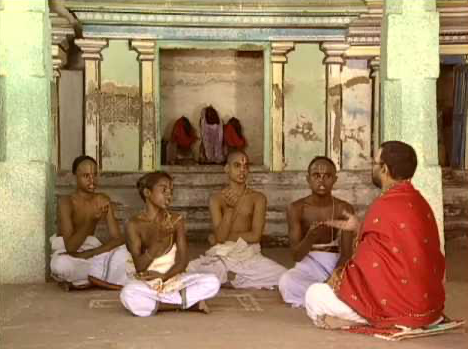The Importance of Sound in Yoga Teaching
- Imogen North
- Mar 17
- 4 min read
The role of sound in yoga classes has long been a subject of debate. Should music accompany a yoga class or should we work in silence? Does chanting or mantra risk alienating students in yoga spaces in the Western world? Should we or shouldn't we use the sounds of the Sanskrit language to communicate on certain poses and principles in practice?
Sound has always played a significant role in transmitting knowledge across yoga traditions. Vedic chanting exemplifies how sound itself is a method of learning and spiritual growth. Rooted in precise patterns of tone, pitch, and rhythm, Vedic chants were designed to be memorised and recited in an oral tradition. Much like Morse code, their structure relies on the interplay of long and short syllables. This rhythmic precision aids in both memorisation and concentration, aligning the mind with the meditative focus essential in yoga.

The Vedas are considered śruti — meaning “that which is heard.” In this sense, sound is seen not just as a tool for learning, but as a divine revelation — a truth heard directly rather than interpreted. Through this understanding, sound becomes a bridge between the external world and inner consciousness.
In some of the Tantric traditions, mantras are far more than verbal recitations — they are living sonic forms of divine energy. Tantric texts describe mantras as embodiments of deities themselves. Sound is seen as a vibrational force capable of invoking transformation. The practice of chanting mantras creates a resonance that aligns the body, mind, and spirit with the cosmic order.
When we look at many of the traditions that our yoga practice stems from instruments also play a symbolic role in devotional worship:
• Bells are rung to announce a devotee’s presence to the Divine.
• String instruments, like the vina, are linked to knowledge and Saraswati, the goddess of wisdom.
• Drums symbolise power and divine authority.
• Horns have historically been used to establish control over spiritual realms or signal communication with the unseen.

In some Indian ascetic traditions, small horn-shaped instruments are believed to protect practitioners and invite divine guidance. Instruments thus amplify the role of sound as a transformative, protective, and sacred force.
The Sama ritual (from the Sufi lineage) emphasises deep listening. (Sama means listening in Arabic). This ritual is in essence a practice of devotional hearing, a practice that mirrors the development of awareness in yoga. Within this tradition, listening itself is a hierarchy:
• Uninitiated listeners may experience brief moments of spiritual awareness.
• Mature listeners cultivate sustained awareness that grows over time.
• Perfected listeners achieve a state of inner stillness in which the Divine presence reveals itself.
This progression mirrors the yogic journey — from distraction to mindfulness to transcendence.
So when we get dictatorial about music and sound in yoga I feel it is important to remember the lineage and acknowledge how music and sound can be a powerful tool for shaping the emotional and energetic arc of a session. Thoughtfully selected music can deepen focus, create flow, and guide students through different stages of practice. As a teacher, your soundscape should complement rather than distract from the journey of your class, matching music to the theme of your class to enhance the experience. If, as a yoga teacher, you don't feel comfortable playing music from the Indian subcontoent then don't. Choose music that sits comfortably into your classes. For example, gentle instrumental music may encourage introspection during restorative poses, while rhythmic beats may energise a more dynamic practice.
We know Yoga is more than a practice of physical postures; it is a discipline that refines awareness — particularly through listening. By attuning to sound, practitioners sharpen their ability to listen inwardly — to the rhythm of their heartbeat, the flow of their breath, or even the vibrations of sound resonating within the body.
In the Hatha tradition, practitioners enter a state of deep inner awareness often described as 'Samadhi' bliss. The journey towards bliss happens in stages and is accompanied by inner sounds, sometimes likened to kettle drums or bells. According to traditional texts, these sounds represent the deepening of practice as awareness shifts from gross external noise to more subtle internal vibrations. The concept of the ‘unstruck sound’ (anāhata nāda) holds profound symbolic meaning. This eternal resonance, said to originate from within the heart, is considered the sound of the Divine. Listening to this inner sound becomes a powerful meditative tool, guiding the practitioner toward stillness and self-realisation.
All this being said I truly believe we should ALSO make space and time in our classes for silence. While sound directs focus and encourages mindfulness, silence plays an equally vital role in our yoga practice. Silence is not merely the absence of sound — it is a profound space of awareness where inner listening unfolds.
Scientifically we know silence has powerful effects on the nervous system. Studies suggest that periods of silence can:
• shift the body from the sympathetic (fight-or-flight) state to the parasympathetic (rest-and-digest) state;
• engage the vagus nerve, which promotes feelings of calm and social connection;
• stimulates brain growth and enhance cognitive clarity.
In a yoga class, silence provides students with a vital opportunity to process their experience; pauses between postures, quiet moments after a deep breath. Just like the sounds, the silence can also be a portal or a doorway into deep listening. The sound awakens awareness, the silence reveals the spaces between those vibrations — reminding us that stillness and sound are two sides of the same coin. Together these two elements create a sensory landscape that invites students to move beyond external noise and tune into their inner world. They are complementary aspects of the non-dual teachings, guiding practitioners toward deeper awareness of our integral connection. Connection to the inner most self, human to human to animal to plant to seemingly inanimate object.



コメント